The Best Toddler Pajamas 2025
The Best Toddler Pajamas. We researched 15 different brands of cotton toddler two-piece pajamas to see which were softest, shrunk least and didn’t break the bank. Of those, we narrowed the list down to the top five choices, based on our reader feedback, online best-seller status and availability. We purchased samples of each brand and then did the testing: washing, measuring for shrinkage and gauging softness.
After we tested the pajama samples (see below for details on how they were tested), we crowned a winner: Burt’s Bees Unisex Pajamas were softest and had no shrinkage after washing. The price was surprisingly reasonable, roughly between ten and twenty bucks per set—it varies by size and pattern. Another plus: they are the only ones we tested that are made of organic cotton and they are GOTS approved.
What’s not to like? The company sews a tag onto the back outside neckline and pants—a few of our readers’ toddlers found this to be a tad itchy, especially near the stitching.
But with that tiny caveat, we think Burt’s Bees toddler pajamas are the best.
Why Trust Us
We’ve been rating and reviewing baby products since 1994. We test baby products here in our offices and we pay for all of test products ourselves. We look to our reader feedback to give us a real world perspective and we also evaluate consumer reviews posted online.
Here’s another key point: we don’t take money from the brands we review. No free samples, no sponsors, no “partnerships.” Baby Bargains is your independent and unbiased source for expert baby gear reviews. We’ve been writing and reviewing baby gear since 1994. Yes, that long!
How we picked a winner
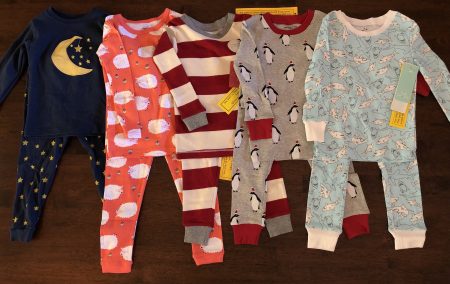
In order to pick our toddler pajama finalists, we scoured our extensive reader generated message boards as well as retailers’ website reviews. Once we had a list of 15 manufacturers (from pricey Hannah Andersson to dirt cheap Costco), we eliminated pajamas made of polyester fleece or cotton/poly blend fabrics—we prefer 100% cotton for breathability.
Also eliminated were onesie styles (which make diaper changing difficult) or loose fitting designs. The latter is a safety issue—close-fitting cotton PJ’s are safer.
We whittled the list down to a top five, then ordered ordered a sample of each brand in a set in size 2T. A set means a long sleeve top and a full length pant, similar to a pair of long johns.
Once we received the pajamas, we measured their underarm seams and inseams to determined a baseline:
Then we ran them through the washing machine and dryer, carefully following directions to wash them inside out and in cold water on delicate (Burt’s Bees was an exception: they listed a warm water wash). Here’s a label Aden + Anais.
After washing, the pajamas were dried on low heat.
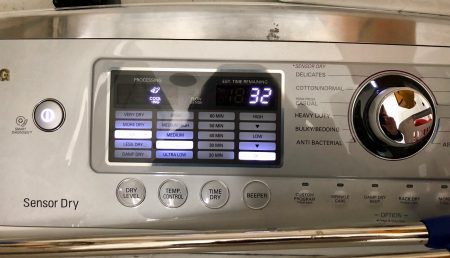
We then remeasured each item to verify any shrinkage. We were surprised to find a couple that did not shrink much at all.
Here are Aden + Anais toddler pajamas. Out of the box (top picture), the sleeve measures 8.95″. Below, after washing, the sleeve measures the same!
Finally, the office staff tested the inside, next-to-skin feel of each pair of pajamas. If a sample had a sewn in label, we checked to see if it seems irritating to the skin. We like the stamped labels because there’s no risk of irritation and you won’t have to remove the label if it bothers baby.
We added up the scores when it came to shrinkage, softness and affordability to come up with a winner.
FYI: While we tested long-sleeve pajamas, the same brand also make short-sleeve versions (called shorties).
5 Things No One Tells You About Buying Toddler Pajamas!
1. Are kids pajamas flame resistant? How do you tell?
Should your child’s sleepwear be flame retardant? What the heck does “flame retardant” mean anyway?
According to the Consumer Product Safety Commission (CPSC), items made of flame retardant fabric will not burn under a “direct flame.” Huh? Doesn’t “flame retardant” mean it won’t burn at all? No—that’s a common myth among parents who think such clothes are a Superman-style second skin that will protect baby against any and all fire hazards.
Prior to 1996, the CPSC mandated that an item labeled as sleepwear be made of “flame retardant fabric.” More often than not, that meant polyester because the alternative (untreated cotton fabric) DOES burn under direct flame. So the de facto standard for children’s sleepwear for many years was polyester.
Then the government changed its mind. The CPSC noticed that many parents were rebelling against the rules and putting their babies in all-cotton items at bedtime. After an investigation, the CPSC revised the rules to more closely fit reality.
First, pajamas for babies nine months and under were totally exempt from the flame-retardant rules. Why? Since these babies aren’t mobile, the odds they’ll come in contact with a fire hazard that would catch their clothes on fire is slim. What if the whole house catches fire? Well, the smoke is much more dangerous than the flames—hence, a good smoke detector in the nursery and every other major room of your house is a much better investment than fire-retardant clothes.
What about sleepwear for older babies? Well, the government admitted that “close-fitting” all-cotton items don’t pose a risk either. Only flowing nightgowns or pajamas that are loose fitting must meet the flame retardant rules today.
Every toddler pajama we purchased included a tag like this:

2. Not all toddler pajamas have stamped labels.
In the old days (okay, not that old), clothing manufacturers used a fabric tag sewn into the garment (usually at the neck) to give parents sizing and care information. Unfortunately, these labels can feel uncomfortable on your kids’ skin. About 10 years ago, manufacturers began using ink stamped label and get rid of the sewn in fabric tag.
Here is a stamped label from Amazon Essentials:
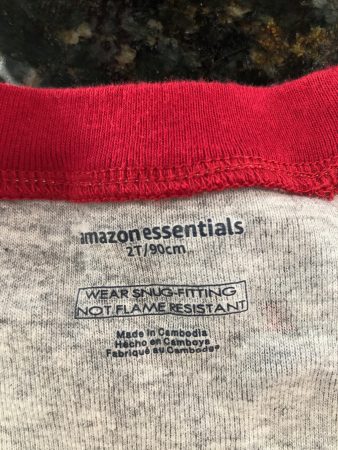
Yes, other manufacturers still have fabric tags–we recommend you avoid them. The other option is to remove them, but if you plan to resell or reuse them, you’ll be tossing out the sizing information too.
FYI, even if the fabric neck tag is missing, you may still find a fabric tag along the back or side seam of the pants.
3. Cotton shrinks. But shrinkage varies by brand.
When we tested toddler pajamas, we were surprised to see that even when we followed the washing instructions scrupulously, shrinkage occurred whether the pajama brand was super affordable or outrageously expensive. The shrinkage was as much as 9% in some cases.
And oddly the pants didn’t always shrink at the same rate as the tops.
In case you’re curious, the Amazon Essentials toddler pajamas shrank the most in our survey: between 7% and 9%. Burt’s Bees and Aden + Anais shrank the least.
Here’s our shrinkage test (sleeves) results from best (no shrinkage) to worst:
Aden + Anais (best)
Burt’s Bee’s
Carter’s
Leveret
Amazon Essentials
When it came to inseams on pants, all brands shrank by between half an inch to 1.25 inches. Here are the shrinkage results (inseam on pant legs) results from best (least shrinkage—about half an inch) to worst.
Burt’s Bee’s (best)
Leveret (tie for first)
Aden + Anais
Carter’s
Amazon Essentials
No matter what brand you buy, you’ll be better off buying the next size up to account for the shrinkage. Especially if you like to throw all the clothes in together and wash them on “normal” rather than delicate. As parents, we often forget to follow washing instructions to a T—and then paid the price when a beloved pair of pajamas shrunk too much in an initial washing.
4. Second hand pjs are a great idea, until your toddler hits age 3.
Children under three probably won’t wear out their pajamas the way kids four and up will. So, you may be able to find some great buys at second hand stores. Keep in mind you don’t want to buy anything with snags or strings. And sizes will not always tell the truth as cotton shrinks. Hold them up to your kiddo or if you really want a work out, try them on him/her.
5. If you’re worried about cold feet, look for kids’ socks with grippy soles to wear around the house or even in bed.
Call them slipper socks or gripper socks, but these guys work well. We’ve seen moccasin types and fleece lined options. Cottock is a brand we’d recommend:
Organic fabric certifications: it’s more than just a label
GOTS (Global Organic Textile Standard) certifies textiles as organic. To meet their qualifications, “Only textile products that contain a minimum of 70% organic fibres can become GOTS certified. All chemical inputs such as dyestuffs and auxiliaries used must meet certain environmental and toxicological criteria. The choice of accessories is limited in accordance with ecological aspects as well. A functional waste water treatment plant is mandatory for any wet-processing unit involved and all processors must comply with minimum social criteria.” Basically, beyond using organic materials, companies must also be socially responsible to their workers and the community.


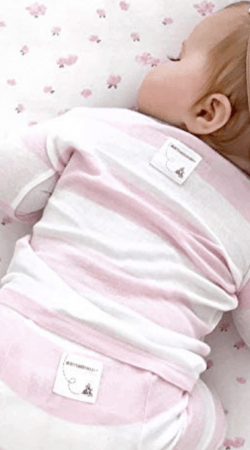
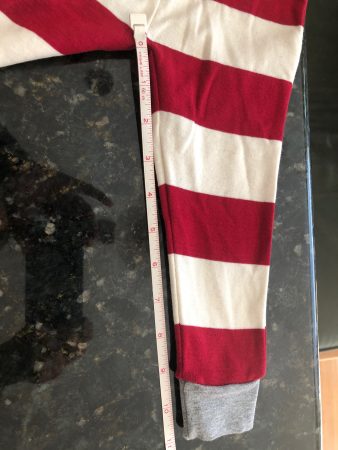
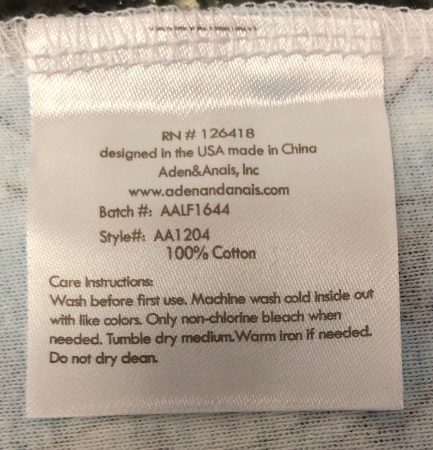
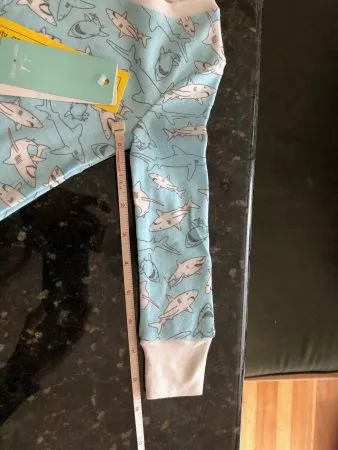



 We obsess over baby gear . . . so you don't have to. Baby Bargains has one mission: help you find the best gear for your baby with unbiased reviews by experts with 20 years of experience. At prices that don't break the bank. When you purchase a product from links on this site, we make a small affiliate commission. Learn more
We obsess over baby gear . . . so you don't have to. Baby Bargains has one mission: help you find the best gear for your baby with unbiased reviews by experts with 20 years of experience. At prices that don't break the bank. When you purchase a product from links on this site, we make a small affiliate commission. Learn more 
